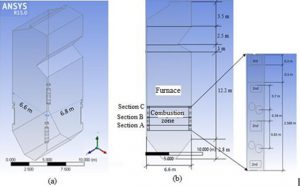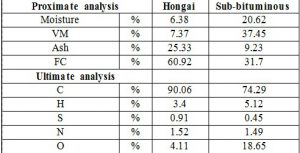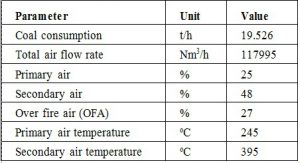Dung, Le Duc (dung.leduc@hust.edu.vn), Linh, Nguyen Huu (nguyenhuulinh050492@gmail.com), Thang, Nguyen Chien Institute of Energy Hanoi, Vietnam thangnc_ie@yahoo.com.
Abstract
This paper presents summarized results of numerical simulation of the flow and combustion process in the furnace of a large scale tangentially fired pulverized coal boiler SG-130-40-450 in NinhBinh thermal power plant through ANSYS ACADEMIC RESEARCH CFD software. The
characteristics of the flow, combustion, temperature and combustion efficiency as well as particle burnout are studied with emphasised on Vietnamese domestic coal, namely Hongai coal. In addition, the influence of blending coal between Indonesia sub- bituminous coal and Hongai coal on the combustion processes was also considered. The predicted results clearly show that ratio of blending coal have an insigficantly on burning rate. An increase in the blending ratio results the faster volatile burning rate and the lower char burning rate in the same simulated conditions.
Index Terms—Numerical simulation, CFD, tangentially fired boiler, blending coal.
I. INTRODUCTION
In Vietnam, coal has played a role key in power generation. According to Power planning vision to 2050 approved by Vietnam government, thermal power plants will account for
49.3 per cent of the total power production. However, domestic coal resource is being depleted and the quality of coal is also reduced. The shortage of coal used to generate power will be 48 million tons by 2020 [1] and be offseted by importing coal.
Pulverized coal combustion is a complicated phenomenon of chemical reactions and depended highly on various factors such as fuel properties, primary air, secondary air and phasing of air supply, particle diameter [3]. Blending coal enables a better control the coal quality and improves combustion efficiency [11]. Besides, blending coal impacts of chracteristics and behaviours of combustion process due to the change of coal components. Therefore, it is nesscessary to characterize the blending coal combustion.
This kind of analysis can be done either by convential experiment or numerical analysis obtaining from appropriate odels using computer. Convential experiment is very expensive, difficult and time consuming for designing and developing the physical models, whilist the availability of high speed computers made it easier to analysis any combustion process by using computational fluid dynamic (CFD) theoretical analysis [3].
The computational fluid dynamics (CFD) of the pulverized coal combustion field is being developed with the remarkable progress in the performance of computers. This method, in which the governing equations of the combustion field are solved using a computer, is capable to provide the detailed information on the distributions of temperature and chemical species and the behavior of pulverized coal particles over entire combustion field that cannot be obtained by experiments. In addition, it facilitates the repeated review in arbitrary conditions for the properties of pulverized coal and the flow field at a relatively low cost [3].
Many CFD studies undertaken of coal combustion relating to tangentially fired furnace, for example [6-10] have shown that CFD provides an accurate tool for predict the behaviour of coal combustion and the results obtainted form these studies are relatively reasonable comparing with the experiment.
The objective of this study is to predict the combustion behaviour of single coal and blending coal when fired in a tangential furnace operated in Vietnam using CFD model. The firstly, the results are emphasised on Vietnamese single coal, namely Hongai coal. Then the influence of blending coal combustion to the combustion process will be assessed in the terms of conversation rate and burning rate of volatile and char.
II. MODEL DESCRIPTION
A. Boiler geometry and operating conditions
The tangentially fired pulverized coal boiler SG-130-40- 450 operated in Ninhbinh thermal power plant was considered in this study. The unit generates 130 tonnes.s-1 of steam at 40 bar and 450oC when operating at full capacity. The geometry of CFD model for the boiler is shown in fig.1. The height of the boiler is approximately 24 m and the horizontal cross section in the furnace is 6.6 x 6.8 m. Eight burners are divided into four groups installed in the four corners ranging from lower group A to upper group B. Each burner consists of two coal burners (fuel rich burner and lean fuel burner) with different air to fuel ratios and segregation rate of coal mass flow rate of 9:1. The burners are of low NOx burner type.

Fig.1. The geometry of boiler SG-130-40-450
The fuels used were Hongai anthracite coal (Vietnamese coal) and sub-bituminous coal (Indonesia imported coal). The properties of the
TABLE 1. COAL PROPERTIESm were given in table 1.

Sub-bituminous coal was blended to Hongai coal ranging from 5 to 20% based on mass fraction and injected simultaneously into furnace. In present model, the blending coal was considered simply as one single coal using averaged properties of component coals. All of the cases were simulated in the same operating conditions shown in table 2.






